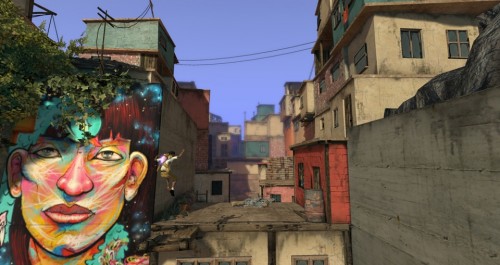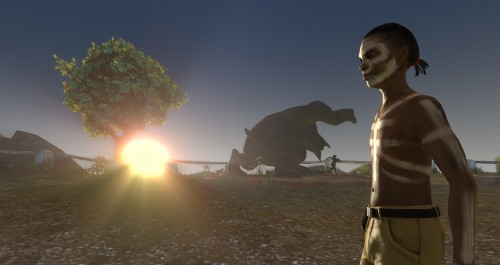This isn’t just a review of Minority Media’s indie gem Papo & Yo, it’s an invitation to set aside any possible preconceptions, expectations and perhaps even a tradition or two, and challenge your mind and heart to open up to this wonderful and ultimately intimate experience. Released with the help of the Sony Pub Fund, it’s one of the best examples of a personal story that doesn’t come at a cost to great gameplay. As a PSN downloadable game, its length and presentation are perfect and firmly establishes its place on any shortlist of essential gaming in the contemporary era of game design.
Stop
If by some miracle this is the first piece of writing you’re reading about Papo & Yo, and have any inclination to play it but haven’t yet, stop reading and go play it now. The less you know, the better the experience will be. Over the years I’ve become well attuned to my tastes and won’t pursue gameplay previews or impressions once I’ve committed to a game and I’m all the better for it. On top of that, as much as I will always enjoy traditional genres and gameplay mechanics, I’m always hungry for works that take gameplay to different places and venture out into the frontiers of design. While Papo & Yo features a traditional 3D environment which is navigated with the usual actions of running, jumping, and climbing, that’s where the tradition ends and the story takes over.
The First Invitation
I’m going to be intentionally vague and become more specific as I progress. If at any point you feel as though you’ve read enough to encourage play, stop and do so. I may seem to be over-cautious which is most likely true, but I’ve learnt that many experiences can be spoiled by too much foreknowledge, that perceptions can be incorrectly coloured to process and interpret what’s being offered.
The first screen to greet players upon selecting a new game from the main menu is a dedication from Creative Director, Vander Caballero, to his family on helping him survive his father. Right from the very beginning, Papo & Yo isn’t going to be a normal story about any of the usual tropes. We then see the protagonist, Quico, huddled in a wardrobe as light spills through its shuttered doors and the silhouette of a monster stomps past. Quico then turns to the rear of the wardrobe where there are chalk marks on the wall, and he falls through into the game-world which is a charming abstract of Brazilian urban spaces. Throughout the game, Quico and NPCs speak in what I initially thought was Portuguese, but have since learned is a semi-made-up language with translated English speech-bubbles, adding to the authenticity and admittedly wonderful indie feel. Each area is constructed mostly of squat, square shacks known in Brazil as favela (http://en.wikipedia.org/wiki/Favela) with a wonderful sense of place as you guide Quico running about amongst them.
Imagination And Action
On the surface the game is about spatial puzzles, though to reduce it to merely thus would be doing it, Minority and Vander a great disservice. As Quico explores the environment he has escaped to, he begins to encounter chalk-lines and objects that greatly transform the space around him. Puzzles begin as fairly straightforward affairs but don’t really launch off into seriously mind-bending challenges and for an important reason. The puzzles have more to do with Quico’s and hopefully the player’s evolving perception of space rather than just being pointless placement of puzzles in an environment with no connection between it and the characters. Once again I invite you, if that sounds appealing, stop reading and start playing, because the next few sentences state things that are better discovered afresh rather than encountered beforehand in text.
The spatial puzzles are in part about giving Quico a bit of empowerment in an increasingly surreal and fantastical world as opposed to him being disempowered in the real one he’s left behind. Each puzzle is more inventive than the last with some that truly made me laugh out loud in delight. at the same time each puzzle is more meaningful than the last, building to a climax that is truly heartfelt and indeed, heartbreaking. Papo & Yo approaches the idea of success in a different way to most games. This isn’t about overcoming adversity by defeating it in combat or out-talking an adversary, it has much more to do with facing fear and acceptance, forcing a degree of maturity onto a child long before it may be necessary.
Character And Meaning
Once again, I implore you to please play the game if you have any inclination to.
Early in Quico’s journey, he encounters a young girl who draws the outline of a door on a concrete wall that seems to then magically permit her to pass through it and disappear. The chalk-line motif is one that repeats throughout the game, blending a child’s sense of magic with this surreal world. She eventually speaks to Quico and acts as something of a guide for him, encouraging him to proceed through the spaces and giving him small insights into his experience. Soon after he meets a character who is called in audio ‘Papo’, or father, but is translated in the English speech bubbles as ‘Monster’. Intentionally or not, this translation creates a connection between the two ideas and combines them. At first, Monster is presented as something threatening but soon enough it’s clear that the large, hulking beast is lazy and seemingly harmless. Quico can provoke Monster to move by wafting fruit beneath his nose as he sleeps, and can then use the fruit to get him to move around spaces where he may be needed to activate some of the fantastical animated objects around.
The first encounter with Monster, learning to interact with him and where it ultimately leads ends up as a beautiful synecdoche of the entire game, something that is revealed upon completion and subsequent reflection and replay sessions. Towards the end of this first encounter with the beast, he and Quico come across some frogs that Monster seems more enthusiastically interested in than the fruit. He eventually catches one and devours it, turning into a raging and flaming version of his namesake and throwing Quico about with violence. It’s a stark contrast to the playfulness that precedes it and suddenly we come to understand that Papo & Yo, which translates to ‘Father & I’ in English, isn’t just about a fantastical adventure of escape, but a story about a child dealing with an alcoholic father.
A Change In Perspective
It’s all too easy for game players of greater levels of literacy to judge Papo & Yo harshly with regards to technical presentation. The most important thing to understand is that the game was created by a small team of around 12 core staff. Minority are not a powerhouse development studio with time, resources and budget to perfect every technical aspect of the game. As such, there is some noticeable screen tearing, an audio buffer issue or two and a few places where players may get Quico stuck and have to reboot to recover, those in particular are quite rare. Were this a fully priced game with a significantly larger budget, these things would be unacceptable, but I beg you to set these issues aside if you can.
Hidden beneath the surface of Papo & Yo is an experience so delightful, so heartfelt and so rich with meaning that it’s miraculous that it’s come to us to play. Regardless of minor technical niggles, the environments remain artistically beautiful with some stunning use of lighting and environment animation. The game also features some great graffiti murals which have been sourced from real-world art that helps create this shanty town full of hidden beauty. Coupled with outstanding music by Brian D’Oliveira that perfectly captures the atmosphere of each moment, the experience is without a doubt cohesive and powerful.
Final Invitation
This is an uncharacteristically short review for me, and intentionally so. It’s not a reflection on the possible lack of worth of the game at all, rather of just how rich it is. There’s so much to be read into Papo & Yo, so many wonderful, frightful and immensely mature ideas. When I think about Papo & Yo, I reflect on a game that has finally tied action to meaning in a most inventive and emotional way, something that few games in history have done. The meaning translates easily through its minute technical difficulties and its beautiful art, music and gameplay design effortlessly shine. It is a game that had me in tears at its conclusion the first three times I played it, and even without the aspect of collecting hats that activates upon the second play-through, warrants replaying just because it’s such a joy. I keep playing Papo & Yo not to collect things or maximise dialogue or option trees, but to experience this introspective, intimate and truly personal story told in some of the best playful ways and spaces created to date.
I invite you one last time to open your heart and mind to the beautiful Papo & Yo.

















